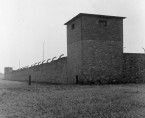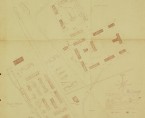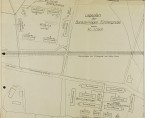Fürstengrube
A sub-camp in Wesoła, near Mysłowice, at a coal mine belonging to Fürstengrube GmbH. IG Farben bought a majority stake in the company, intending to use the mine in the future as a dependable supplier of coal to the Buna-Werke, the plant the company was building in Monowice. Jews from a nearby forced-labor camp were employed to build the barracks that would house Auschwitz prisoners. The camp was made up of six wooden residential barracks and outbuildings surrounded by a barbed-wire fence with four guard towers. The first director of the camp, SS-Hauptscharführer Otto Moll, was succeeded by SS-Oberscharführer Max Schmidt. There were more than 60 SS men in the garrison.
The first 500 prisoners were brought to Wesoła at the beginning of September 1943. Afterwards, the population rose to more than 1,200 the following June. More than 90 percent were Jews from Poland, and later from Belgium, France, Bohemia, and Hungary as well. There were about 20 to 30 Germans, and similar numbers of Poles and Russians.
They labored mostly in the old mine (Altanlage), at the coal face, or building the new mine (Neuanlage)—both in very poor conditions. Their productivity was estimated to be half that of civilian workers. Mine management was dissatisfied with this state of affairs and wrote to the sub-camp director complaining that he was coddling the prisoners. This is hard to believe; partially extant death statistics reveal that at least 400 sick and exhausted prisoners were sent to Birkenau after selection in the first half of 1944, and that 76 prisoners died in the sub-camp itself in the second half of that year.
During the evacuation of Fürstengrube, about a thousand prisoners were marched to Gliwice and transported from there to Germany by rail. Several days later, the SS murdered the sick prisoners in the sub-camp, who had been left behind because they could not stand the march, by directing automatic rifle fire at the barracks and throwing hand grenades inside. Some sick prisoners were burned alive inside the hospital barracks. Only a dozen or so prisoners survived the massacre by hiding before it began or lying motionless beneath heaps of bodies when it was over. Polish miners took them into their care after liberation.


